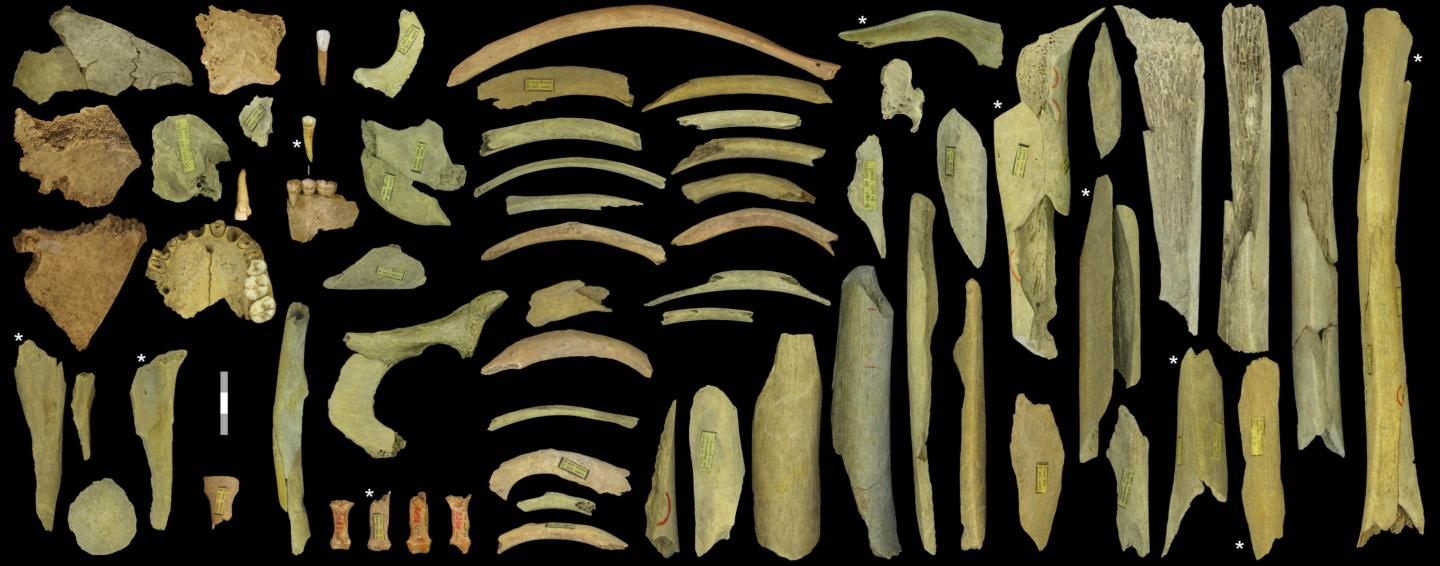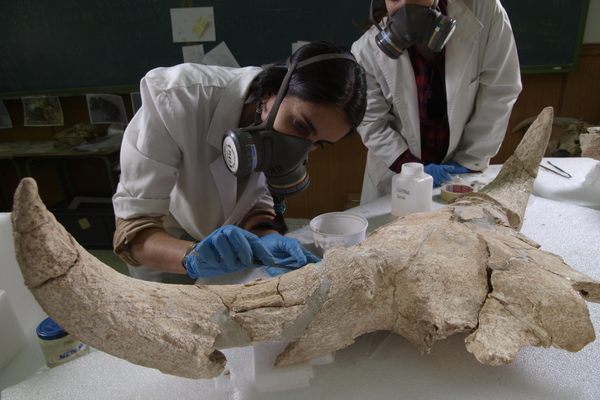Evidence of Neanderthal Cannibalism Puzzles Researchers
The largest discovery of cannibalized Neanderthal remains provides a few answers and a lot of questions.

The highly fragmented Neanderthal collection of the third cave at Goyet represents at least five individuals. Dating indicates that the ones marked with an asterisk go back to between 40,500 and 45,500 years ago. Scale=3cm. (Photo: Asier Gómez-Olivencia, et al./CC BY-4.0)
A team of researchers led by Dr. Hélène Rougier of California State University has announced a landmark discovery in the journal Scientific Reports this week. The team has uncovered evidence of cannibalism among a population of Neanderthals at the Goyet cave site in Belgium—the first discovery of Neanderthal cannibalism in Northern Europe.
Paleoanthropologists have debated evidence for Neanderthal cannibalism for over 100 years, since researchers first discovered remains believed to show evidence of cannibalism in Croatia, although those findings were later disproven. More recently, cannibalized remains were found in France in 1999, Spain in 2006, and in other parts of Southern Europe.
The Goyet remains, which consist of four adolescent or adult neanderthals and one child—the largest discovery of cannibalized remains in Northern Europe—exhibit cut marks where flesh and muscle was separated from bone and percussion marks where bones were crushed to extract marrow. The research team concluded the remains were processed for consumption based on the similar treatment of horses and reindeer remains also found at the site. Because there is no evidence that modern humans were in the area, the scientists believe it is most likely the remains were butchered by other Neanderthals. Basically, it’s a clear case of cannibalism.
There’s also evidence the remains weren’t solely used as a food source, as some bones appear to have been used as tools to reshape or sharpen stones. Neanderthals’ use of other Neanderthals’ bones as tools has been seen before in Croatia and France, but the quantity found in Belgium far surpasses what has been recovered at the other sites. Eerily, the researchers note that the living Neanderthals “may have been aware that they were using human remains” as tools, although it’s unclear whether the use was ceremonial or functional.
While the discovery represents “unambiguous evidence” that Neanderthals in Northern Europe practiced cannibalism, the findings shed little light on the motivations behind the behavior. In the published results, the research team argues that the state of preservation of the remains makes it “highly unlikely” that cannibalism was part of a funerary rite, although they acknowledge that it’s ultimately “impossible to infer the behavioural signature represented by these remains.”
In fact, remains found at sites nearby emphasize that cannibalism was not consistently practiced by Neanderthals; one site even contained remains buried (uneaten) as part of a funerary rite. So what happened in this case?
It’s hard to say but there are some telling details. Radiocarbon dating revealed that the bones are 40,500 to 45,500 years old, which is just about the time Neanderthals died out in Europe. Additionally, mitochondrial DNA testing shows that the Neanderthals found in Belgium are genetically similar to those found in Germany, Croatia, and Spain, which means the population of Neanderthals in Europe at that time was likely very small.
Similar to the Goyet remains, the 2006 discovery of cannibalized Neanderthal remains in El Sidrón, Spain, was dated to 43,000 years ago. In that case, lead researcher Antonio Rosas told National Geographic that the cannibalism may have been motivated by food shortages, particularly since the remains showed evidence of periods of malnutrition. Given that Neanderthals were on their way out when both the El Sidrón and Goyet cannibalism occurred, it doesn’t seem farfetched to suggest that both populations were struggling to survive.
But regardless of the motivation behind the cannibalism, the discovery at Goyet shows that Neanderthal behavior towards the dead was far from uniform, despite lack of genetic variability. This behavioral variety is another demonstration that Neanderthals were far more complicated than humans previously believed.







Follow us on Twitter to get the latest on the world's hidden wonders.
Like us on Facebook to get the latest on the world's hidden wonders.
Follow us on Twitter Like us on Facebook